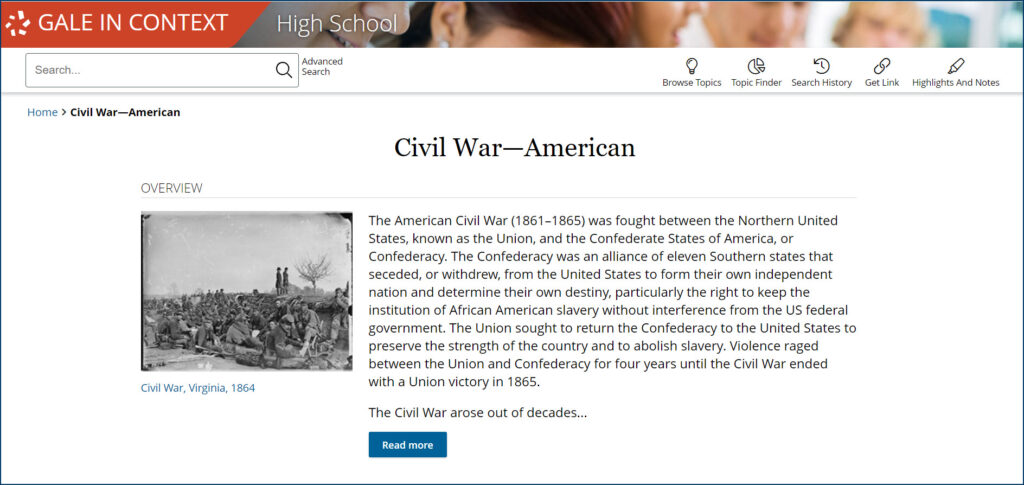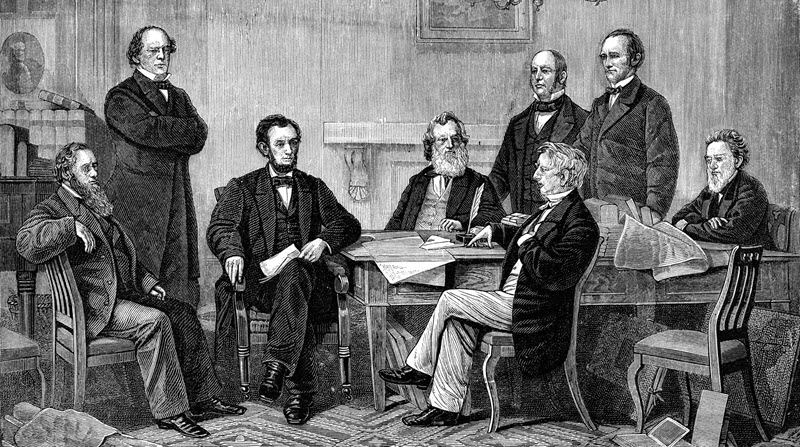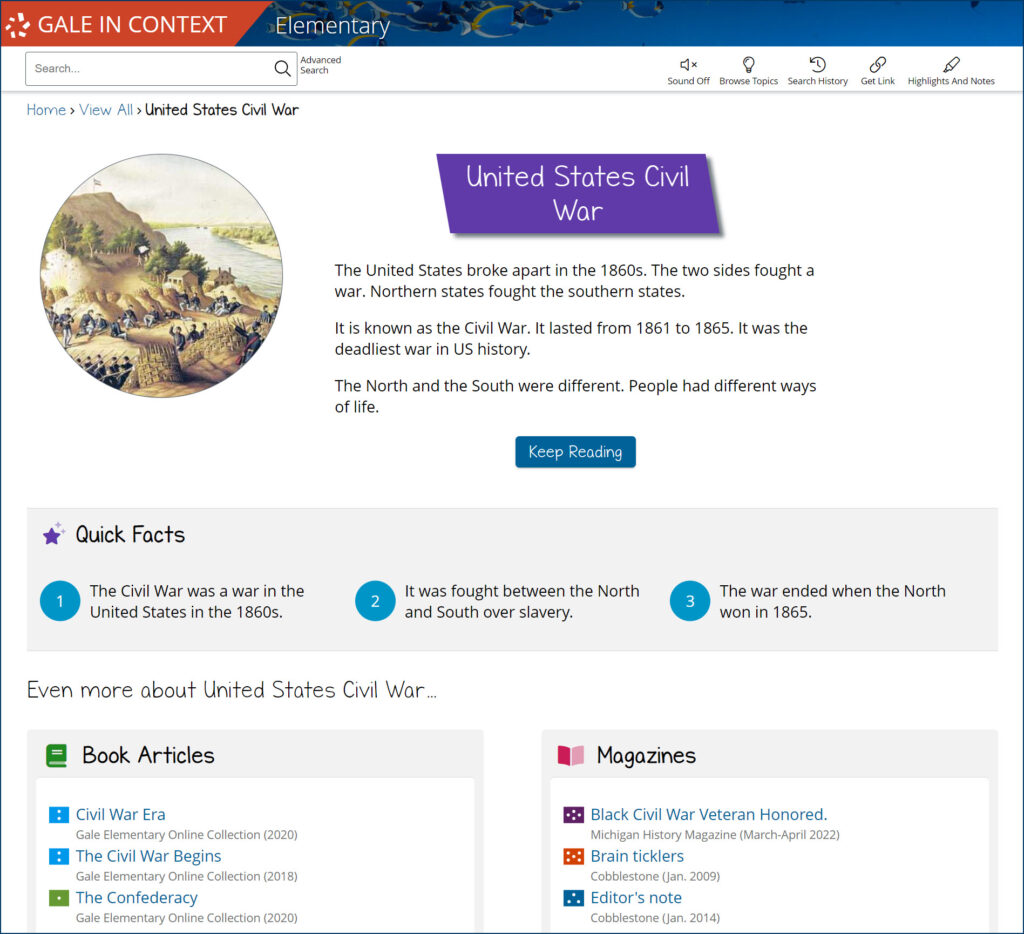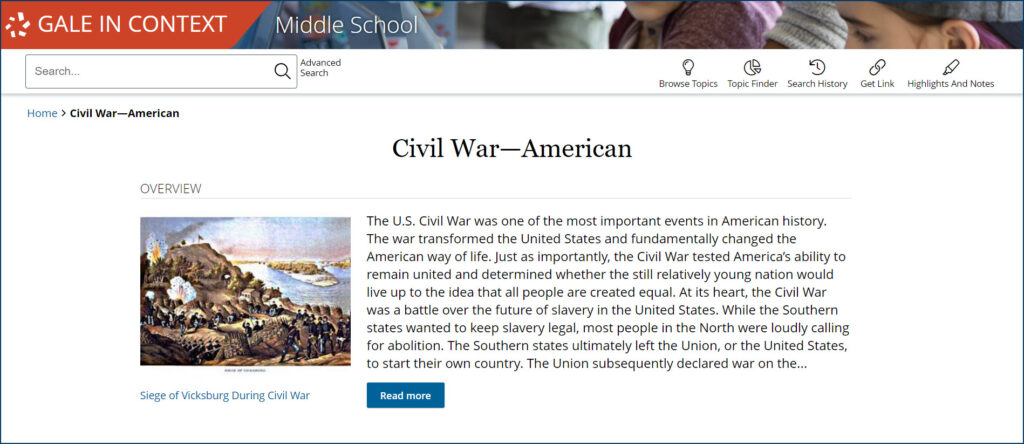| By Gale Staff |
The American Civil War is a tragic chapter of our country’s history. Beginning on April 12, 1861, and ending nearly four years later in 1865, the Civil War claimed the lives of more than half a million Americans. More Americans died in the Civil War than in World War I and World War II combined.
Teachers can rely on Gale’s impressive research collections, individually curated for elementary-, middle school– and high school–level learners. Gale In Context databases host comprehensive archives of articles, documents, biographical entries, images, videos, and podcasts. Our team vets materials for accuracy and age-appropriateness, letting you take a step back to allow your students to develop their independent research skills and curiosity.
Plus, every Gale In Context resource includes our extensive accessibility features, including translations, downloadable text-to-speech files, and adjustable text options. These customizations empower your students to engage with content at a pace and in a format that supports their individual learning needs.
No matter the grade you teach, you can leverage Gale In Context products to augment your American Civil War lesson plans. Integrate these fascinating and user-friendly collections to dive into the past and learn about a pivotal moment in our country’s history.
Start Teaching the Civil War at an Early Age
The issues that fueled the American Civil War present a valuable opportunity to discuss our country’s foundational building blocks, such as basic freedoms, the independent rights of each state, and the abolition movement. For elementary students, focus on the conflict’s causes and present simplified yet powerful questions; help them consider how personal beliefs and unshakable convictions could pit brothers against each other on the battlefield.
To assist in these efforts, explore Gale In Context: Elementary. This kid-friendly database presents information in a simple, approachable, and appropriate format. You don’t have to worry about students stumbling across graphic images or disturbing information. Begin with the dedicated U.S. Civil War portal, featuring a helpful summary page, including a list of central ideas and a general timeline. The summary breaks down the basics to accommodate your students’ budding research skills.
From there, you might focus on the key players throughout the war. Students can find streamlined biographies with fascinating tidbits. Did you know Ulysses S. Grant, who led the Union Army to victory, became the country’s first four-star general? Abraham Lincoln, our 16th president, taught himself how to read and write as a child. Clara Barton, founder of the American Red Cross, was a nurse on the frontlines throughout the war. Frederick Douglass, the famous abolitionist, worked with President Lincoln to recruit African American soldiers to the Union Army. Meeting this fascinating cast of characters and learning the overarching motivations behind the conflict will provide a strong foundation for advanced learning later on.
Continue Learning Through Middle School
For many, the first in-depth Civil War unit occurs in middle school. Students are maturing and asking bigger questions. They can handle the more challenging facts about life as a Civil War soldier and the war’s battles while wrestling with the complicated tensions that instigated the war.
To examine these more intricate details, turn to Gale In Context: Middle School. While sharing the same accessibility tools and user-friendly search features as the elementary version, this database integrates more advanced resources to meet your students’ elevated learning needs. The collection’s Civil War portal includes fascinating primary source materials and images that provide more context to the war’s brutal realities and casualties. Students can begin researching the war’s individual battles, tracking the conflict’s shifting tides, and studying significant milestones, like the Emancipation Proclamation and the Gettysburg Address.
Middle school students will learn more about the politics of the Confederacy versus the Union, hear victorious stories about African American soldiers, and grapple with accounts from a prisoner-of-war camp. They will learn the details behind the war’s more memorable moments, inspiring deeper consideration of war’s moral motivations and consequences.
Discuss the Long-Term
Effects with Your High Schoolers
While typically emphasized within a middle school curriculum, the American Civil War is still important for high school students to revisit, especially within the conflict’s long-lasting social and political effects. As a positive consequence of the conflict, Congress outlawed slavery and provided citizenship and the right to vote to formerly enslaved persons.
Gale In Context: High School offers students the necessary resources to tackle these complexities. The Civil War summary provides in-depth content on its background, tension, battle strategy, and the events that ultimately led to the Union’s victory. They will learn about the conflict’s aftereffects in southern states, the Reconstruction Era, and evolving American perceptions of equality.

The Civil War did not necessarily resolve tensions between the North and South; many Southern states held lingering resentment and racist convictions despite the post-war legislation and reunification efforts. Fueled by this anger, the infamous John Wilkes Booth assassinated Abraham Lincoln just days after the war ended. Despite new federal freedoms afforded to its Black citizens, Southern states crafted new frameworks for racial segregation.
The war’s after-effects inform many of today’s major social conflicts. Through their study on the post–Civil War era, your high schoolers will no doubt discover parallels to current conversations. Learning about the Civil War provides context to stories about the dismantling of Confederate statues, advocacy against voter suppression laws, the ongoing debate around state rights, and controversy around ways to teach about slavery and the Civil War. Understanding the framework for and long-lasting effects of the Civil War helps students become more informed and socially-minded citizens.
The Civil War provides powerful learning opportunities and helps inform the roots of modern-day issues. Regardless of the grade you teach, Civil War unit lessons have a place within the curriculum. Gale In Context databases can help you customize your classroom research to fit your students’ academic levels, evolving maturity, and expanding critical thinking abilities.
If your school does not subscribe to Gale, contact your local representative now and request a trial.



